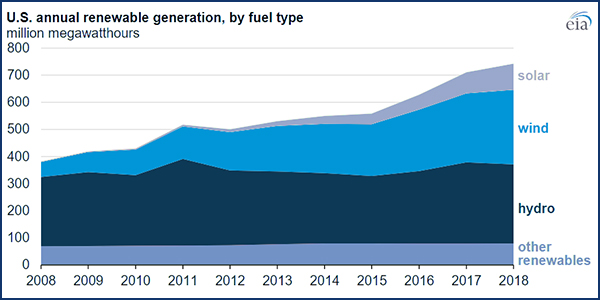By Christen Smith
U.S. renewable electricity generation nearly doubled over the last decade, the Energy Information Administration reported Tuesday.
Solar, wind and hydroelectric resources provided 742 million MWh of electricity in 2018, up from 382 million MWh produced a decade earlier. Wind and solar generation accounted for 90% of the increase, the agency said.
Wind generation grew 80% between 2008 and 2018 to 275 million MWh, accounting for 6.5% of total electricity generation. Solar, meanwhile, exploded from just 2 million MWh to 96 million MWh, composing 2.3% of total generation last year. Utility-scale installations accounted for 69% of last year’s solar output, with small-scale rooftop, customer-sited resources contributing the rest.
Wind capacity jumped from 25 GW to 94 GW over the decade, while solar capacity surged from less than 1 GW to 51 GW. Conventional hydroelectric capacity increased just 2%, although output varied widely over the period based on water conditions.
EIA attributed the growth in renewables to federal policies (such as the production and investment tax credits), state-level programs (such as renewable portfolio standards) and declining costs.
“As more wind and solar projects have come online, economies of scale have led to more efficient project development and financing mechanisms, which has led to continued cost declines,” the agency said.
Tuesday’s figures came on the heels of a March 11 EIA report showing that Texas, Iowa and Oklahoma added 4,000 MW of wind capacity last year, composing 60% of the new units brought online in 2018. California, Florida and North Carolina built a majority of the 4,900 MW of solar photovoltaic generation added in 2018, according to the report.
Pennsylvania Dominates New Gas Capacity
Meanwhile, natural gas-fired generators dominated new U.S. capacity additions last year, with nearly a quarter of the 19.3 GW of new units coming online in Pennsylvania alone. Maryland, Florida and Virginia combined accounted for an additional 30% of the new gas-fired resources, the EIA found. Nearly 90% of all new gas units were combined cycle, the agency said.
EIA said the U.S. added a total of 31,300 MWh of generation and retired 18,700 MWh in 2018. Inefficient coal plants and natural gas steam and combustion turbine units accounted for the majority of the retirements, with just one nuclear plant – Oyster Creek in New Jersey – shutting down.
The results underscore the continuing struggle of coal plants to maintain market share as state policies push developers toward cleaner, more efficient technologies. Gas-fired energy output exceeded coal for the first time in PJM, the Independent Market Monitor said on Thursday. (See Monitor Says PJM’s Capacity Market Not Competitive.)
In December, EPA relaxed regulations on newer coal-fired plants as nationwide consumption hit its lowest point in 39 years. (See EPA Eases Rules for New Coal Generation.) Coal retirements for the year came in as the second most on record, according to EIA, with another 4,000 MW of capacity scheduled for retirement by the end of 2019.






